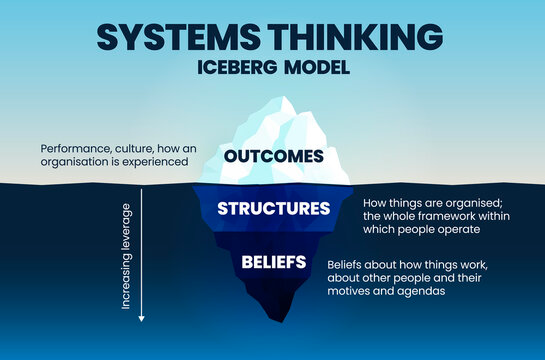How Systems Coaching Helps Organizations Discover and Develop Their Unique Strengths
Companies like Zappos, Spotify, Amazon and Netflix have not become world-wide successes by adopting an agile framework like SAFe. Instead, they are continually working on improving the whole organization by helping employees see and understand the entire value-generating system they are a part of, embrace agile values and principles, and to develop the capabilities needed to effectively implement agile practices.

What is Systems Coaching?
Systems coaching is a process of transforming the way an individual, team or organization thinks about and operates within their environment.
The goal of systems coaching is to help people and organizations uncover actionable insights together, and enable them to create sustainable plans for change. Systems coaching is not about imposing an agile framework, telling people what they should do or how they should do it. It’s about guiding them, step-by-step, to reach a common understanding of the current challenges and explore potential ways forward.
What are the Benefits of Systems Coaching?
Any organization is a system consisting of people, processes, technology and underlying mindsets. Systems coaching is a process of exploring and changing systems that are not working for us. The coach helps the client to explore their structures and practices as well as their own thoughts, feelings, and beliefs about themselves and others.
Many change initiatives fail because people do not have a common understanding of the problems or agree on the right course of action. Systems coaching can help an entire organization to identify its strengths and weaknesses, the areas where it needs development, and what steps to take in order to achieve its goals.

The Process of Systems Coaching
Systems coaching is a process where the coach helps the client identify and change structures, processes, behaviors and mindsets that are not serving them.
The process of systems coaching involves 5 steps:
- Identify the problem areas in the current organization
This can be done by conducting an assessment of the organization’s current practices and processes, as well as gathering input from employees and stakeholders. This assessment can help to identify any bottlenecks or inefficiencies in the current ways of working, as well as any cultural or organizational barriers that may be preventing the organization from fully embracing agile principles, which will help the coach and client identify what they want to change. - Explore underlying systemic causes of the challenge
This step involves jointly creating various forms of systems maps to visualize the relationships and interactions within the organization, and to identify any patterns or trends that may be contributing to the identified challenges. Constellations is a technique of allowing people to move, sort and organize themselves in an open space based on prompts or questions. This can surface profound insights in a group in a short amount of time. - Identify the right areas of action
This can involve using tools such as iceberg maps or causal loop diagrams to identify the underlying systemic causes of the problem and help focus efforts on addressing the root causes of the issue, rather than just the symptoms. This will lead to more sustainable and effective solutions. - Run experiments to improve in the selected focus areas
In this stage, all parties work together on creating hypotheses, performing experiments and measuring results. - Lastly, there’s reflection
During this stage of systems coaching, the organization reflects on what worked well during implementation and what didn’t go as planned in order to improve on the next round of experiments.
How an Organization Can Leverage the Process and Benefit from it
Systems coaching is a unique tool that allows organizations to spend their energy where they will get the most bang for their bucks. It identifies the leverage points and capabilities that could significantly contribute to their success, or — if left unchanged — would hinder progress.
The process is simple. The coach will work with an organization to identify the issues they want to work on and then create collaborative workshop experiences where they can explore these issues. Using exercises like the examples above together with tools and practices like the integral model, role enactment, perspective-taking and group reflection, a common understanding develops.
The coach guides and prompts the participants through the completion of exercises that are tailored specifically for them. The end goal is to help employees identify what is holding the organization back and what they need in order to improve their collective performance and make them more productive.
The benefits of this process are numerous, but some of the most important ones are that it invites participation from everybody involved, fosters collective a-ha moments resulting in aligned improvement efforts, silo-busting, higher employee engagement and ownership, more effective leadership, better cross-team collaboration, and reduced turnover rates.
How Systems Coaching is the Next Step for Organizations Embracing Business Agility
Agile principles are about people and interactions over processes and tools. This means that agility is not just about how quickly an organization can release new features or products in their DevOps toolchain, but also how quickly they can adapt to changes in their environment or actually change strategy.
Systems coaching is the next step for organizations embracing business agility. It involves working with an organization to create not just agile teams, but infusing an organization-wide structure, culture and practice that embodies the agile principles in order to innovate and deliver value to customers in a more timely and efficient manner. This requires helping the organization to collectively identify and address any and all barriers that may be preventing them from fully embracing really agile mindsets and practices.
Overall, systems coaching can help an organization to reach the next level of performance by taking an honest look at themselves, initiating the right conversations across the whole enterprise and fostering a culture of continuous learning and improvement. By shining a light on old patterns and structures standing in their way, this can enable the organization to identify and develop the skills and knowledge needed to become truly agile.
How Systems Coaching Helps Organizations Discover and Develop Their Unique Strengths was originally published in Compendium on Medium, where people are continuing the conversation by highlighting and responding to this story.